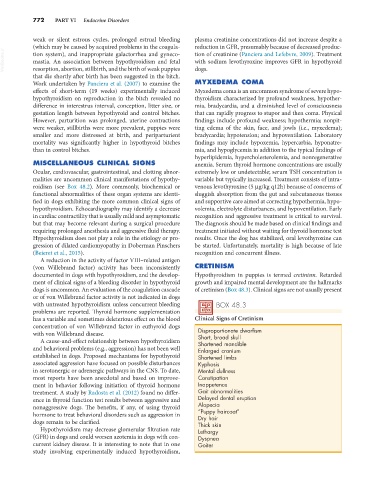Page 800 - Small Animal Internal Medicine, 6th Edition
P. 800
772 PART VI Endocrine Disorders
weak or silent estrous cycles, prolonged estrual bleeding plasma creatinine concentrations did not increase despite a
(which may be caused by acquired problems in the coagula- reduction in GFR, presumably because of decreased produc-
VetBooks.ir tion system), and inappropriate galactorrhea and gyneco- tion of creatinine (Panciera and Lefebvre, 2009). Treatment
with sodium levothyroxine improves GFR in hypothyroid
mastia. An association between hypothyroidism and fetal
resorption, abortion, stillbirth, and the birth of weak puppies
that die shortly after birth has been suggested in the bitch. dogs.
Work undertaken by Panciera et al. (2007) to examine the MYXEDEMA COMA
effects of short-term (19 weeks) experimentally induced Myxedema coma is an uncommon syndrome of severe hypo-
hypothyroidism on reproduction in the bitch revealed no thyroidism characterized by profound weakness, hypother-
difference in interestrus interval, conception, litter size, or mia, bradycardia, and a diminished level of consciousness
gestation length between hypothyroid and control bitches. that can rapidly progress to stupor and then coma. Physical
However, parturition was prolonged, uterine contractions findings include profound weakness; hypothermia; nonpit-
were weaker, stillbirths were more prevalent, puppies were ting edema of the skin, face, and jowls (i.e., myxedema);
smaller and more distressed at birth, and periparturient bradycardia; hypotension; and hypoventilation. Laboratory
mortality was significantly higher in hypothyroid bitches findings may include hypoxemia, hypercarbia, hyponatre-
than in control bitches. mia, and hypoglycemia in addition to the typical findings of
hyperlipidemia, hypercholesterolemia, and nonregenerative
MISCELLANEOUS CLINICAL SIGNS anemia. Serum thyroid hormone concentrations are usually
Ocular, cardiovascular, gastrointestinal, and clotting abnor- extremely low or undetectable; serum TSH concentration is
malities are uncommon clinical manifestations of hypothy- variable but typically increased. Treatment consists of intra-
roidism (see Box 48.2). More commonly, biochemical or venous levothyroxine (5 µg/kg q12h) because of concerns of
functional abnormalities of these organ systems are identi- sluggish absorption from the gut and subcutaneous tissues
fied in dogs exhibiting the more common clinical signs of and supportive care aimed at correcting hypothermia, hypo-
hypothyroidism. Echocardiography may identify a decrease volemia, electrolyte disturbances, and hypoventilation. Early
in cardiac contractility that is usually mild and asymptomatic recognition and aggressive treatment is critical to survival.
but that may become relevant during a surgical procedure The diagnosis should be made based on clinical findings and
requiring prolonged anesthesia and aggressive fluid therapy. treatment initiated without waiting for thyroid hormone test
Hypothyroidism does not play a role in the etiology or pro- results. Once the dog has stabilized, oral levothyroxine can
gression of dilated cardiomyopathy in Doberman Pinschers be started. Unfortunately, mortality is high because of late
(Beieret et al., 2015). recognition and concurrent illness.
A reduction in the activity of factor VIII–related antigen
(von Willebrand factor) activity has been inconsistently CRETINISM
documented in dogs with hypothyroidism, and the develop- Hypothyroidism in puppies is termed cretinism. Retarded
ment of clinical signs of a bleeding disorder in hypothyroid growth and impaired mental development are the hallmarks
dogs is uncommon. An evaluation of the coagulation cascade of cretinism (Box 48.3). Clinical signs are not usually present
or of von Willebrand factor activity is not indicated in dogs
with untreated hypothyroidism unless concurrent bleeding BOX 48.3
problems are reported. Thyroid hormone supplementation
has a variable and sometimes deleterious effect on the blood Clinical Signs of Cretinism
concentration of von Willebrand factor in euthyroid dogs Disproportionate dwarfism
with von Willebrand disease. Short, broad skull
A cause-and-effect relationship between hypothyroidism Shortened mandible
and behavioral problems (e.g., aggression) has not been well Enlarged cranium
established in dogs. Proposed mechanisms for hypothyroid Shortened limbs
associated aggression have focused on possible disturbances Kyphosis
in serotonergic or adrenergic pathways in the CNS. To date, Mental dullness
most reports have been anecdotal and based on improve- Constipation
ment in behavior following initiation of thyroid hormone Inappetence
treatment. A study by Radosta et al. (2012) found no differ- Gait abnormalities
ence in thyroid function test results between aggressive and Delayed dental eruption
nonaggressive dogs. The benefits, if any, of using thyroid Alopecia
“Puppy haircoat”
hormone to treat behavioral disorders such as aggression in Dry hair
dogs remain to be clarified. Thick skin
Hypothyroidism may decrease glomerular filtration rate Lethargy
(GFR) in dogs and could worsen azotemia in dogs with con- Dyspnea
current kidney disease. It is interesting to note that in one Goiter
study involving experimentally induced hypothyroidism,

